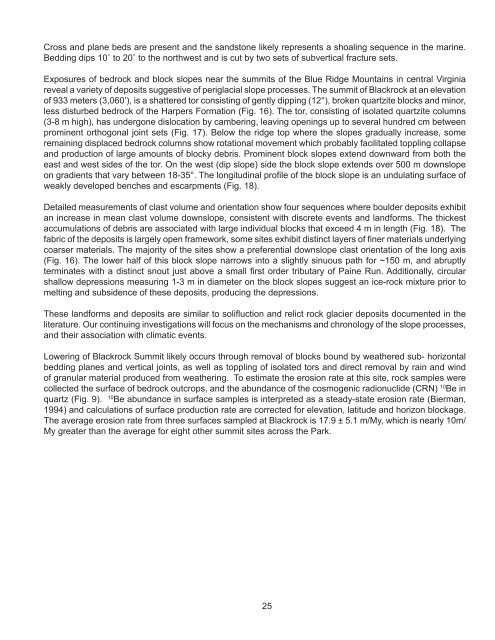Geology of the Shenandoah National Park Region - Csmres Jmu ...
Geology of the Shenandoah National Park Region - Csmres Jmu ...
Geology of the Shenandoah National Park Region - Csmres Jmu ...
Create successful ePaper yourself
Turn your PDF publications into a flip-book with our unique Google optimized e-Paper software.
Cross and plane beds are present and <strong>the</strong> sandstone likely represents a shoaling sequence in <strong>the</strong> marine.<br />
Bedding dips 10˚ to 20˚ to <strong>the</strong> northwest and is cut by two sets <strong>of</strong> subvertical fracture sets.<br />
Exposures <strong>of</strong> bedrock and block slopes near <strong>the</strong> summits <strong>of</strong> <strong>the</strong> Blue Ridge Mountains in central Virginia<br />
reveal a variety <strong>of</strong> deposits suggestive <strong>of</strong> periglacial slope processes. The summit <strong>of</strong> Blackrock at an elevation<br />
<strong>of</strong> 933 meters (3,060’), is a shattered tor consisting <strong>of</strong> gently dipping (12°), broken quartzite blocks and minor,<br />
less disturbed bedrock <strong>of</strong> <strong>the</strong> Harpers Formation (Fig. 16). The tor, consisting <strong>of</strong> isolated quartzite columns<br />
(3-8 m high), has undergone dislocation by cambering, leaving openings up to several hundred cm between<br />
prominent orthogonal joint sets (Fig. 17). Below <strong>the</strong> ridge top where <strong>the</strong> slopes gradually increase, some<br />
remaining displaced bedrock columns show rotational movement which probably facilitated toppling collapse<br />
and production <strong>of</strong> large amounts <strong>of</strong> blocky debris. Prominent block slopes extend downward from both <strong>the</strong><br />
east and west sides <strong>of</strong> <strong>the</strong> tor. On <strong>the</strong> west (dip slope) side <strong>the</strong> block slope extends over 500 m downslope<br />
on gradients that vary between 18-35°. The longitudinal pr<strong>of</strong>ile <strong>of</strong> <strong>the</strong> block slope is an undulating surface <strong>of</strong><br />
weakly developed benches and escarpments (Fig. 18).<br />
Detailed measurements <strong>of</strong> clast volume and orientation show four sequences where boulder deposits exhibit<br />
an increase in mean clast volume downslope, consistent with discrete events and landforms. The thickest<br />
accumulations <strong>of</strong> debris are associated with large individual blocks that exceed 4 m in length (Fig. 18). The<br />
fabric <strong>of</strong> <strong>the</strong> deposits is largely open framework, some sites exhibit distinct layers <strong>of</strong> finer materials underlying<br />
coarser materials. The majority <strong>of</strong> <strong>the</strong> sites show a preferential downslope clast orientation <strong>of</strong> <strong>the</strong> long axis<br />
(Fig. 16). The lower half <strong>of</strong> this block slope narrows into a slightly sinuous path for ~150 m, and abruptly<br />
terminates with a distinct snout just above a small first order tributary <strong>of</strong> Paine Run. Additionally, circular<br />
shallow depressions measuring 1-3 m in diameter on <strong>the</strong> block slopes suggest an ice-rock mixture prior to<br />
melting and subsidence <strong>of</strong> <strong>the</strong>se deposits, producing <strong>the</strong> depressions.<br />
These landforms and deposits are similar to solifluction and relict rock glacier deposits documented in <strong>the</strong><br />
literature. Our continuing investigations will focus on <strong>the</strong> mechanisms and chronology <strong>of</strong> <strong>the</strong> slope processes,<br />
and <strong>the</strong>ir association with climatic events.<br />
Lowering <strong>of</strong> Blackrock Summit likely occurs through removal <strong>of</strong> blocks bound by wea<strong>the</strong>red sub- horizontal<br />
bedding planes and vertical joints, as well as toppling <strong>of</strong> isolated tors and direct removal by rain and wind<br />
<strong>of</strong> granular material produced from wea<strong>the</strong>ring. To estimate <strong>the</strong> erosion rate at this site, rock samples were<br />
collected <strong>the</strong> surface <strong>of</strong> bedrock outcrops, and <strong>the</strong> abundance <strong>of</strong> <strong>the</strong> cosmogenic radionuclide (CRN) 10 Be in<br />
quartz (Fig. 9). 10 Be abundance in surface samples is interpreted as a steady-state erosion rate (Bierman,<br />
1994) and calculations <strong>of</strong> surface production rate are corrected for elevation, latitude and horizon blockage.<br />
The average erosion rate from three surfaces sampled at Blackrock is 17.9 ± 5.1 m/My, which is nearly 10m/<br />
My greater than <strong>the</strong> average for eight o<strong>the</strong>r summit sites across <strong>the</strong> <strong>Park</strong>.<br />
25


